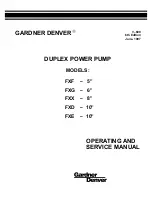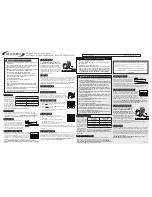
P S - 7 0 4 F O U R - C H A N N E L P O W E R S U P P L Y
1 - 7
TO CHECK BEFORE POWERING SYSTEM
Before you turn on the power:
CHECK TERMINATION
There should be one and only one termination for each channel in the system.
This termination is usually set to
on
at the main station or power supply. To
ascertain that only one termination is present on the channel, perform the
following test:
1. Using a multimeter, measure the resistance between pins #1 and #3 on one
of the channel A XLR connectors at the rear of the unit.
2. If the channel is terminated properly, then the resistance should measure
approximately 4 K
Ω
. A very high channel resistance means the channel is not
terminated. Channel resistance of 2 K
Ω
indicates a double-termination. If a
double-termination is indicated, locate the other power supply or main
station and set its termination to
off
.
Note:
The location of the termination switch varies with model. On some
products, the termination switches are on the rear panel; on others,
they are inside the unit. Consult the unit’s manual for the location.
3. Repeat for the other channels.
4. Check resistance between chassis ground and pin #1. Using an Ohmmeter,
measure the resistance from pin #1 on the main station or power supply to
chassis ground. The measurement should read 10
Ω
. A high reading (over
100
Ω
) indicates that the 10
Ω
resistor in the unit has failed and requires
replacement. Failure to perform the replacement will result in an audible
“buzz” in the system. A reading of less than 10
Ω
(or a short) typically
indicates that the shell and pin #1 of one of the interconnect cables are
shorted together. Test the individual cables until the culprit is located and
repair or replace the cable.
Caution: Pin #1 and the shell of the
XLR
plug on the interconnect cables
should NOT be connected together.
CHECK INTERCOM CABLE RESISTANCE
For minimal crosstalk, the ground resistance of the intercom cables should be as
low as possible, preferably less than 2
Ω
. Disconnect an intercom line from the
main station or power supply. At the point in the intercom line furthest from the
unit, connect a clip lead jumper between pins #1 and #2. Back at the “powered”
end, use an Ohmmeter to measure the resistance between pins #1 and #2. A
value of less than 4
Ω
is ideal.
FINAL TESTS
After you turn the power on:
1. Check for proper voltage on pin #2 of any intercom line or jack in a channel.
It should read 26 to 30 volts.














































